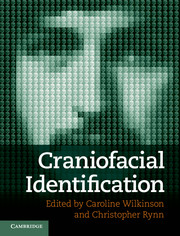Book contents
- Frontmatter
- Contents
- Contributors
- Part I Identification of the Living
- Part II Identification of the Dead
- Chapter 14 Post-mortem prediction of facial appearance
- Chapter 15 Manual forensic facial reconstruction
- Chapter 16 Relationships between the skull and face
- Chapter 17 Automated facial reconstruction
- Chapter 18 Computer-generated facial depiction
- Chapter 19 Craniofacial superimposition
- Chapter 20 Juvenile facial reconstruction
- Index
- Plate Section
- References
Chapter 18 - Computer-generated facial depiction
Published online by Cambridge University Press: 05 May 2012
- Frontmatter
- Contents
- Contributors
- Part I Identification of the Living
- Part II Identification of the Dead
- Chapter 14 Post-mortem prediction of facial appearance
- Chapter 15 Manual forensic facial reconstruction
- Chapter 16 Relationships between the skull and face
- Chapter 17 Automated facial reconstruction
- Chapter 18 Computer-generated facial depiction
- Chapter 19 Craniofacial superimposition
- Chapter 20 Juvenile facial reconstruction
- Index
- Plate Section
- References
Summary
Introduction
Numerous computerised craniofacial reconstruction (CFR) systems have developed since the early pioneering work by Moss et al. (1987). Many of these systems were designed to produce more time-efficient, less subjective and more reliable CFR, with the ultimate goal of complete automation. However, automated computer systems may impose a very specific set of facial characteristics and may be reliant upon facial templates (Arridge et al., 1985; Evison et al., 2003), average tissue depths (Vanezis et al., 1989, 2000; Evenhouse et al., 1992) and population-specific databases (Stratomeier et al., 2005). Advances in haptic (tactile feedback interface) technology and 3D rendering software have also enabled the development of computerised systems which replicate the practitioner-led manual methods, rather than following the automated approach. These systems attempt to recreate characteristic facial morphology, and a more individualistic likeness than an approximation. Some computerised systems employ 3D animation software (Buhmann et al., 2003; Eliasova et al., 2003; Evison et al., 2003; Kahler et al., 2003; Kindermann, 2003) to model the face onto the skull, whilst other systems employ virtual sculpture software and hardware with haptic feedback (Wilkinson, 2003). The systems with haptic feedback have the advantage of allowing the practitioner to feel the surface of the skull during analysis, which provides some important skeletal detail for CFR, such as location of the malar tubercle or muscle attachment rugosity. These 3D-modelling systems have also been utilised to follow facial approximation methods (Subke and Wittke, 2005). Computerised CFR systems which require anthropological interpretation and computer modelling skills are, in general, more time consuming than the approximation systems.
There are many benefits to computer-based CFR systems. Where the skull is fragmented, some computerised systems allow skull reassembly (Subke and Wittke, 2005; Wilkinson, 2005), and this is more efficient and rapid than manual reassembly, as no physical scaffold is necessary and no damage to the specimen is possible. Computerised remodelling of missing fragments is significantly easier than manual methods, and may reduce the amount of necessary time from days to hours. Computerised systems also allow a more realistic facial appearance than the manual methods, creating familiar images consistent with photographs or film sequences (Friend, 2003; Lorenzi, 2004; BBC News, 2010).
- Type
- Chapter
- Information
- Craniofacial Identification , pp. 222 - 237Publisher: Cambridge University PressPrint publication year: 2012
References
- 3
- Cited by



